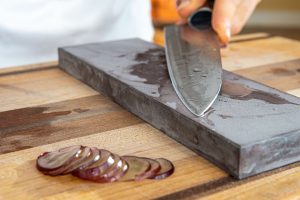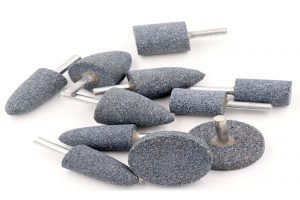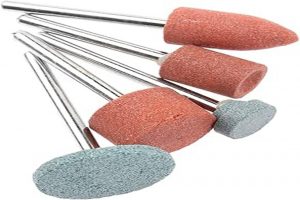Home / News & Blog / Abrasive Blog / Bonded Abrasives – Whetstones, Grinding Stones, Grinding Heads and Tumbling Grinding Blocks
Bonded abrasives are versatile tools essential for various grinding, polishing, and finishing applications. They come in forms such as whetstones, grinding stones, grinding heads, and tumbling grinding blocks, each designed to cater to specific needs in industries like metalworking, mold processing, and precision manufacturing. These tools are indispensable in achieving desired surface finishes, improving tool sharpness, and refining workpiece shapes. With variations in grain sizes and materials, bonded abrasives offer tailored solutions for everything from coarse grinding to ultra-fine polishing, demonstrating their importance across diverse manufacturing and maintenance tasks.
1. Whetstones

Whetstones are grinding tools commonly used for fine grinding and polishing. It is widely used for grinding tool cutting tools and finishing in mold processing. The name of whetstone comes from the need to add lubricant (usually oil or water) when using it to reduce friction, improve the grinding effect, and avoid overheating. Whetstone is usually in the form of an elongated block, which is convenient for manual operation or use with hand tools. Common shapes include long strips, triangles, semicircles, etc.
The grit of whetstone is usually fine, and suitable for fine grinding and polishing. Common grit sizes are as follows:
Coarse Grain Size: F60-F120, suitable for rough grinding or finishing of knives and tools, to remove more materials. For example, the rough grinding whetstone commonly used by fitters is used to remove the notch on the cutting edge of the tool or the burr of rough processing.
Medium Grit: F180-F320, suitable for medium-precision grinding and finishing. Often used for grinding cutting tools or molds, it can effectively remove the deep scratches left after rough grinding. For example, the finishing and grinding of the mold surface requires this medium-grained whetstone to improve the surface flatness.
Fine Grit: F400-F600, used for fine polishing and fine processing. Suitable for fine grinding of tools or finishing of mold surfaces, providing a higher surface finish. For example, the final sharpness of the tool or the improvement of the surface finish of the mold requires this fine grit stone.
Ultra-fine Grit: F800-F1200 and above, used for ultra-fine polishing and grinding, especially in situations where extremely high surface finish is required, such as polishing of precision molds, final grinding of tools, etc. For example, ultra-fine grit whetstones are used for mirror polishing of precision molds or edge treatment of high-end tools.
2. Grinding Stones

Although whetstones and grinding stones are somewhat similar in manufacture and function, both are tools used to grind and polish the surface of workpieces, they differ in shape and specific applications. Grinding Stone has various shapes, most commonly large blocks or round shapes. It is generally used for rough grinding and polishing of larger areas. It is often used for deburring, trimming, or preliminary processing of workpieces, and has a strong grinding force. It is often used in machine tools or manual operations and is suitable for large-area grinding operations. The particle size of the grinding stone is generally coarse, suitable for rough grinding and large-area material removal. The common particle size range is as follows:
Coarse Grain Size: F24-F60, suitable for rapid material removal, commonly used for rough grinding, deburring, and surface grinding. For example, in metal processing, it is used to quickly remove welds, oxide layers, or large areas of burrs. For example, deburring of castings or preliminary finishing of metal parts.
Medium Grit: F80-F150, for medium grinding, capable of removing material while maintaining a certain surface flatness. Suitable for initial finishing of workpieces that require further precision improvement. For example, in stone processing or metal workpiece finishing, grinding stones can be used to smooth the surface while retaining a certain cutting force.
Fine Grit: F180-F320, suitable for fine processing or finishing of smooth surfaces. Fine-grained grinding stones are suitable for finishing and improving surface finish after grinding. For example, using such grinding stones for polishing can make the surface of metal parts, stone, or ceramics smoother.
Ultra-fine Grit: F400 and finer, for final finishing of extremely smooth surfaces or high precision grinding. Although whetstones are mainly used for coarse grinding, ultra-fine grits are also used in some demanding surface finishes. For example, when polishing ceramic or glass products, ultra-fine grit whetstones may be used to achieve a smooth surface finish.
Grinding blocks usually refer to more regularly shaped whetstones, such as rectangular or square, which are used exclusively for manual or machine grinding, especially for grinding and dressing larger surfaces. Grinding blocks are commonly used in grinding machines, hand-held tools, etc.
3. Grinding Heads

The grinding head is a small grinding tool installed on a grinding machine or power tool, used for internal grinding, fine finishing, and local precision machining of workpieces. It is composed of abrasive particles, a binder, and a metal shaft handle. It grinds the material on the surface of the workpiece through high-speed rotation to remove burrs, trim the shape, and improve the finish.
Grinding heads can be divided into ceramic grinding heads, resin grinding heads, rubber grinding heads, etc. according to different bonding agents. They can be divided into corundum grinding heads, silicon carbide grinding heads, diamond grinding heads, and CBN grinding heads according to different abrasives. They can also be divided into the following according to their shapes:
Cylindrical Grinding Heads: used for grinding inner holes, removing inner wall materials, etc. They are suitable for internal grinding or surface grinding.
Spherical Grinding Heads: used for grinding grooves and inner angles, suitable for trimming curved parts or recessed areas.
Conical Grinding Heads: used for trimming holes or chamfering, also used for grinding the bottom of the inner hole.
Bowl-shaped and dish-shaped grinding heads: suitable for surface grinding, often used for precision machining and polishing. In short, grinding heads are widely used as tools for internal grinding, dressing, and precision machining. They have a variety of shapes and abrasive types to suit different machining needs. According to the material and machining accuracy of the workpieces, different grinding heads and different particle sizes (F24-F600 and above can be used) can be selected to ensure efficient and high-precision grinding effects.
4. Tumble Grinding Blocks

Tumbling grinding blocks are abrasive tools commonly used for surface treatment. They are typically made from conventional abrasives such as aluminum oxide or silicon carbide, and sometimes synthetic abrasives. These blocks are used in tumblers or vibratory polishing machines and are widely applied in deburring, polishing, and enhancing surface smoothness of materials like metal, plastic, and ceramics. They are suitable for various workpiece shapes and are particularly effective for batch processing of small workpieces.
Tumble polishing blocks usually have irregular shapes or geometric shapes (such as cones, spheres, triangles, etc.) to facilitate uniform contact with the workpiece in a drum or vibratory polishing machine. The shape design can help achieve a more uniform grinding effect on different workpieces. Tumble polishing blocks can vary in hardness and particle size depending on the needs of the specific application. Common tumble polishing block types and particle sizes are mainly divided into the following categories based on the processing materials and process requirements:
Resin Grinding Blocks: F36-F120, used for deburring and surface grinding of metal parts.
Ceramic Grinding Blocks: F46-F220, suitable for coarse and medium grinding of metal and non-metal, with higher hardness.
Plastic Grinding Blocks: F60-F240, gentle grinding, suitable for softer materials such as aluminum alloy.
Metal Grinding Blocks: F80-F400, suitable for fine grinding of hard materials.
Bonded abrasives serve diverse functions in shaping, finishing, and polishing. Whetstones excel in sharpening and fine grinding while grinding stones handle rougher, large-area tasks. Grinding heads allow precise, detailed work, and tumbling blocks are perfect for batch polishing and deburring. These tools ensure efficiency and high-quality results across applications.